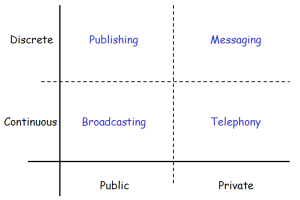This is something that I’ve been mulling over for a little while, and I’m hoping that by posting it here, the discipline of having to write it down will clarify it for me. And, perhaps people reading this will comment on the ideas and help flesh them out a bit more.
A variety of industries have developed that deal with interpersonal communications at a distance. Each of them has crystalised around their own set of technologies. However, there seems to be a blurring of the boundaries between them these days, and in order to better understand what this means, it could be helpful to understand how the underlying technologies of these industries relate.
If you simply consider two properties of technologies used by the communications industries, it appears that you can draw some reasonable boundaries. The two properties I’m thinking of are privacy and continuousness, and by building a simple 2×2 matrix out of them, you get the following diagram:

Admittedly, the separation between Public and Private is a little fuzzy. Does sending something to 10 of your closest friends make something public? What about 100? What about 1,000? Does it depend on the friends? However, I think it is reasonably well understood that you can have private group communication, not just private one-on-one communication. I think we also usually know when we are engaging in something that is highly (publicly?) visible, and something that is private, despite the occasional exception.
And while the distinction between discrete and continuous communication ought to be unambiguous, it too has its fuzziness. A discrete communication is one where the communication itself has a clearly defined boundary, e.g. an image, a movie, a book, a song, or an article. While a continuous communication lasts as long as the communications channel is maintained, e.g. a TV channel, a radio channel, a telephone call, or a video conferencing session. Recordings tend to be discrete while performances tend to be continuous.
But, what if you watch a movie on the TV, or listen to a song on the radio? This is an example of convergence between the different industries. Once a movie or a song is published, the broadcast network can distribute it, although it loses some of its discreteness in the process.
Similarly, there is convergence between the broadcasting and telephony industries. A reporter can call into a news station, and have their story broadcast out to the viewers. Or when your call is put on hold, you may end up listening to a live radio station.
Convergence between telephony and messaging is well understood within the telco realm. You can call and leave a voicemail for someone, which becomes a message they can later retrieve. Or it might be transcribed and then delivered as a text message. Or it could be send as an audio attachment in an email. Or instead of leaving the voicemail, you could record an audio MMS and send that instead. And if a SMS is sent to a fixed phone that cannot display it, a phone call can be generated instead with text-to-speech used to render the message audible.
However, what has become most interesting of all recently is the convergence between messaging and publishing. This blog post is an act of publishing. However, I could have sent it via email to a few of my friends, and that would have been messaging. Instead of emailing it, I can make it available via Facebook. If it is made available to my network of friends, it is messaging. But, with the click of a button I can change my preferences so that Notes are public, so it is publishing.
One of the interesting aspects to social networking for me is that some networks are designed primarily around a messaging model (like Facebook or Friendster) and others around a publishing model (like Myspace or Twitter). As the social networks all compete to offer similar features, the sharp lines between the models get very blurred.
Related articles by Zemanta
- MySpace Transformation Coming? (crenk.com)
- Skype’s New Dawn? (loosewireblog.com)
- Twitter welcomes MMS as Orange turn on UK Twits (allaboutsymbian.com)
- Justin.tv makes it easier to create and share live video (digital.venturebeat.com)
![Reblog this post [with Zemanta]](http://img.zemanta.com/reblog_e.png?x-id=9912f7b3-496c-48dd-939b-048bdb8aafd8)

![Reblog this post [with Zemanta]](http://img.zemanta.com/reblog_e.png?x-id=15bee8bd-9916-4d1e-8367-f36b1c57c6f6)

![Reblog this post [with Zemanta]](http://img.zemanta.com/reblog_e.png?x-id=71fde1bb-57ba-4fc7-b12b-18549ac72c38)

![Reblog this post [with Zemanta]](http://img.zemanta.com/reblog_e.png?x-id=db3e2d64-cfac-4c74-a525-7fc7f57b5c8c)